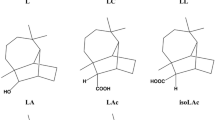Abstract
Eight valencenoid derivatives were evaluated for their repelling activity against Formosan subterranean termites, Coptotermes formosanus Shiraki. Among them, 1,10-dihydronootkatone was the strongest repellent, and valencene was the weakest. Results of the structure–repellency relationships indicated (1) reduction of the ketone group to the alcohol on position 2 of nootkatone curtailed the activity; (2) because of the low activity of valencene relative to nootkatone that the ketone group was essential for repellent activity; (3) reduction of the 1,10 double bond (1,10-dihydronootkatone and tetrahydronootkatone) produced compounds more repellent than nootkatone; (4) the isopropenyl group probably does not participate in binding as evidenced by no significant difference in the repellent activity among nootkatone (double bond between position 11 and 12), isonootkatone (double bond between position 7 and 11), and 11,12-dihydronootkatone.
Similar content being viewed by others
References
Anonymous. 1998. SAS User's Guide: Statistics. SAS Institute, Cary, NC.
Ahmad, F. B., Mackeen, M. M., Ali, A. M., Mashirun, S. R., and Yaacob, M. M. 1995. Repellency of essential oils against the domiciliary cockroach, Periplaneta americana. Insect Sci. Appl. 16:391–393.
Cornelius, M., Grace, J. K., and Yates, J. R., III. 1997. Toxicity of monoterpenoids and other natural products to the Formosan subterranean termite. J. Econ. Entomol. 90:320–325.
Franzios, G., Mirotsou, M., Hatziapostolou, E., Kral, J., Scouras, Z. G., and Mavragani-Tsipidou, P. 1997. Insecticidal and genotoxic activities of mint essential oils. J. Agric. Food Chem. 45:2690–2694.
Garlaschelli, L., Melleric, G., and Vita-Finzi, P. 1994. New fatty acid esters of drimane sesquiterpenes from Lactarius uvidus. J. Nat. Prod. 57:905–910.
Harborne, J. B. 1991. Recent advances in the ecological chemistry of plant terpenoids, pp. 399–426, in J. B. Harborne and F. A. Tomas-Barberan (ed.). Ecological Chemistry and Biochemistry of Plant Terpenoids. Clarendon, Oxford.
Isman, M. 1999. Pesticides based on plant essential oils. Pestic. Outlook. May: 68–72.
Laine, R. A. and Sweeley, C. C. 1971. Analysis of trimethylsilyl O-methyloximes of carbohydrates by combined gas-liquid chromatography–mass spectrometry. Anal. Biochem. 43:533–538.
La Fage, J. P., Su, N-Y., Jones, M. J., and Esenther, G. R. 1983. A rapid method for collecting large numbers of subterranean termites from wood. Sociobiology 7:305–310.
Lewis, D. L., Michaels, G. E., Hays, D. B., Campbell, W., and Smith, V. 1978. Evaluation of the anti-termitic activity of hydroxyquinoline and naphthol derivative formulations using Reticulitermes in laboratory and field experiments. J. Econ. Entomol. 71:818–821.
Maistrello, L., Henderson, G., and Laine, R. A. 2001. Efficacy of vetiver oil and nootkatone as soil barriers against Formosan subterranean termite (Isoptera: Rhinotermitidae). J. Econ. Entomol. 94:1523–1537.
Miyazawa, M., Nakamura, Y., and Ishikawa, Y. 2000. Insecticidal sesquiterpene from Alpinia oxyphylla against Drosophila melanogaster. J. Agric. Food Chem. 48:3639–3641.
Nagnan, P. and Clement, L. L. 1990. Terpenes from the maritime pine Pinus pinaster: Toxins for subterranean termites of the genus Reticulitermes (Isoptera: Rhinotermitidae). Biochem. Syst. Ecol. 18:13–16.
Ngoh, S. P., Choo, L. E. W., Pang, F. Y., Huang, Y., Kini, M. R., and Ho, S. H. 1998. Insecticidal and repellent properties of nine volatile constituents of essential oils against the American cockroach, Periplaneta americana (L.) Pestic. Sci. 54:261–26.
Odom, H. C. and Pinder, A. R. 1972. Synthetic experiments in the eremophilane sesquiterpene group. Synthesis of (+)-7-epi-nootkatone and partial synthesis of velerianol. The structure of nardostachone. J. Chem. Soc. [Perkin I.] 17:2193–2197.
Rice, E. L. 1983. Pest Control with Nature's Chemicals: Allelochemicals and Pheromones in Gardening and Agriculture. University of Oklahoma Press, Stillumtr, 224pp.
Rice, P. J. and Coats, J. R. 1994a. Insecticidal properties of monoterpenoid derivatives to the house fly (Diptera: Muscidae) and red flour beetle (Coleoptera: Tenebrionidae). Pestic. Sci. 41:195–202.
Rice, P. J. and Coats, J. R. 1994b. Insecticidal properties of several monoterpenoids to the house fly (Diptera: Muscidae), red flour beetle (Coleoptera: Tenebrionidae), and southern corn rootworm (Coleoptera: Chrysomelidae). J. Econ. Entomol. 87:1172–1179.
Rice, P. J. and Coats, J. R. 1994c. Structural requirements for monoterpenoid activity against insects, pp. 92–108, in ACS Symposium Series 557. Am. Chem. Soc. Washington, DC.
Shaaya, E., Ravid, U., Paster, N., Juven, B., Zisman, U., and Issarev, V. 1991. Fumigant toxicity of essential oils against four major stored-product insects. J. Chem. Ecol. 17:499–504.
Sharma, R. N., Tungikar, V. B., Pawar, P. V., and Vartak, P. H. 1994. Vapour toxicity and repellency of some oils and terpenoids to the termite, Odontotermes brunneus. Insect Sci. Appl. 15:495–498.
Spiro, R. 1964. Periodate oxidation of the glycoprotein fetuin. J. Biol. Chem. 239:567–573.
Stevens, K. L., Guadagni, D. G., and Stern, D. J. 1970. Odour character and threshold values of nootkatone and related compounds. J. Sci. Food. Agric. 21:593–593.
Wakabayashi, N., Wu, W. J., Waters, R. M., Redfern, R. E., Mills, G. D., Jr., Demilo, A. B., Lusby, W. R., and Andrzejewski, D. 1988. Celangulin: A nonalkaloidal insect antifeedant from Chinese bittersweet, Celastrus angulatus. J. Nat. Prod. 51:537–542.
Zhu, B. C. R., Henderson, G., Chen, F., Maistrello, L., and Laine, R. A. 2001a. Nootkatone is a repellent for Formosan subterranean termite (Coptotermes formosanus). J. Chem. Ecol. 27:523–531.
Zhu, B. C. R., Henderson, G., Chen, F., Fei, H., and Laine, R. A. 2001b. Evaluation of vetiver oil and seven insect-active essential oils against the Formosan subterranean termite. J. Chem. Ecol. 27:1617–1625.
Zhu, B. C. R., Henderson, G., Fei, H., Ying, X., and Laine, R. A. 2003. Terpene-induced morphological changes to exoskeleton of Formosan subterranean termites (Isoptera: Rhinotermitidae): Toxic effects of cis-nerol. J. Entomol. Sci. 38:225–233.
Author information
Authors and Affiliations
Rights and permissions
About this article
Cite this article
Zhu, B.C.R., Henderson, G., Sauer, A.M. et al. Structure–Activity of Valencenoid Derivatives and Their Repellence to the Formosan Subterranean Termite. J Chem Ecol 29, 2695–2701 (2003). https://doi.org/10.1023/B:JOEC.0000008013.07845.4c
Issue Date:
DOI: https://doi.org/10.1023/B:JOEC.0000008013.07845.4c




